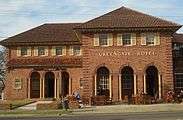Killara is a suburb on the Upper North Shore of Sydney in the state of New South Wales, Australia 14 kilometres (8.7 mi) north of the Sydney Central Business District in the local government area of Ku-ring-gai Council. East Killara is a separate suburb and West Killara is a locality within Killara.
History
Killara is an Aboriginal word meaning permanent or always there.[2] The name of the suburb was chosen when the railway line opened in 1899. James George Edwards was a representative of the people who requested a station be built here. The suburb was established as a 'Gentlemen's suburb', designed so that there would be no commercial ventures in the area. For this reason, the suburb has very few shops in the original development.[2]
Killara Post Office opened on 7 November 1904.[3]
Killara later became the home of the famous architect Harry Seidler, whose home -- designed by him and his wife Penelope in the 1960s -- can still be seen in Kalang Avenue. It is sometimes known as Killara House and sometimes as Harry and Penelope Seidler House. The couple moved in to the house on Harry Seidler's birthday in 1967. The garden contains a sculpture by the Los Angeles sculptor Eric Orr. The house is heritage-listed.[4]
Infrastructure and development
Killara railway station is on the North Shore, Northern & Western Line of the Sydney Trains network. The Pacific Highway is the main road through Killara. Churches in the suburb comprise St Martin's Anglican Church and Killara Uniting Church (formerly Killara Congregational Church) on Karranga Avenue.
The Swain Gardens were donated to Ku-ring-gai Council by Mr Swain, a Sydney bookseller, in the 1920s, and are today maintained by the council and volunteers. The gardens have been listed by the National Trust of Australia.
Schools
Killara is served by two top ranking public primary schools, Killara Public School and Beaumont Road Public School.[5] The suburb is also home to Killara High School, the highest performing non-selective government secondary school in the state of New South Wales.[6][7]
| Greengate Hotel, Pacific Highway |
| St Martin's Anglican Church |
|
Commercial
Commercial developments are located along the length of the Pacific Highway, including the Greengate Hotel. A small group of shops are located on Marian Street, close to Killara railway station; Marian Street Theatre (closed in December 2013) is located opposite.
Residential
The majority of residential properties are built in the Federation and Californian Bungalow styles, although the suburb includes many other styles.
The Harry and Penelope Seidler House at 13 Kalang Avenue was designed by Harry and Penelope Seidler. The 1960s-era modern-design home, constructed with reinforced masonry walls, concrete floors and roof, rubble-stone retaining walls and fireplace, won the Wilkinson Award in 1967.
At the 2011 census, approximately two-thirds (65.9%) of the residences in Killara were separate houses. The remainder were almost all flats, units or apartments. The average household size was 2.8 people.[1]
| Federation house, Arnold Street |
| Federation bungalow, Northcote Avenue |
| Arts and crafts house, Arnold Street |
| Tudor revival house, Arnold Street |
| Tudor revival house, Stanhope Road |
| Neoclassical (post-war) house, Stanhope Road |
| Federation revival house, Springdale Road |
| Contemporary home, Kylie Avenue |
| Modern house (c. 2005), Arnold Street |
|
Politics
For federal elections, Killara lies in the electorate of Bradfield, currently represented by Paul Fletcher. For state elections, Killara falls under the state electoral districts of Davidson and Ku-ring-gai. Kuring-gai is represented by Alister Henskens. The member for Davidson is Jonathan O'Dea. In terms of local government, Killara is part of the Ku-ring-gai municipal council.
Population and demographics
.jpg)
Rosetta Avenue
In the 2011 Australian census, the total population of Killara was 9,284 people; 46.9 percent were male and 53.1 percent were female. The number of residents born in Australia was 59.3 percent. Of those born overseas, the most common countries were China (6.1%), the United Kingdom (5.1%), Hong Kong (3.6%), New Zealand (2.2%), and South Korea (2.2%). In Killara, 70.2 percent only speak English, with other commons languages spoken including Cantonese (7.2%), Mandarin (6.5%), Korean (2.6%), and Japanese (1.1%). The largest religious affiliation was "no religion" (24.2%), followed by Anglican (21.8%), Catholicism (20.3%), Uniting Church (6.3%), and Presbyterian and Reformed (3.9%). Of persons aged 15 years and over, 58.3% were married, 28.3% never married, 4.6% divorced, 7.2% widowed and 1.5% separated.[1]
Killara is an affluent suburb. The median weekly personal income was A$841, compared with A$577 in Australia. The median weekly household income was A$2,508, compared with A$1,234 in Australia. The median weekly family income was A$2,729, compared with A$1,481 in Australia.[1]
Notable residents
References
External links
Coordinates: 33°46′07″S 151°09′48″E / 33.76864°S 151.16347°E / -33.76864; 151.16347
_03.jpg)
.jpg)

_01.jpg)
_03.jpg)
.jpg)
.jpg)
_02.jpg)
_02.jpg)
.jpg)
.jpg)
.jpg)
_02.jpg)
.jpg)
Old_English_style_house_Killara-1.jpg)
Seidler_house_Kalang_Avenue-3.jpg)